Post by ferrari512s on Feb 4, 2014 0:11:23 GMT -5

The Pontiac Firebird - The History - The Details!

Below is an image of the 1967 Pontiac Firebird prototype. It was close to the production car however most of us can notice the differences.

There was a time when the Pontiac Firebird wasn't a cliche. It was a real driving force of style and engineering! Notice the look of this beauty below.

3D Concept Design!
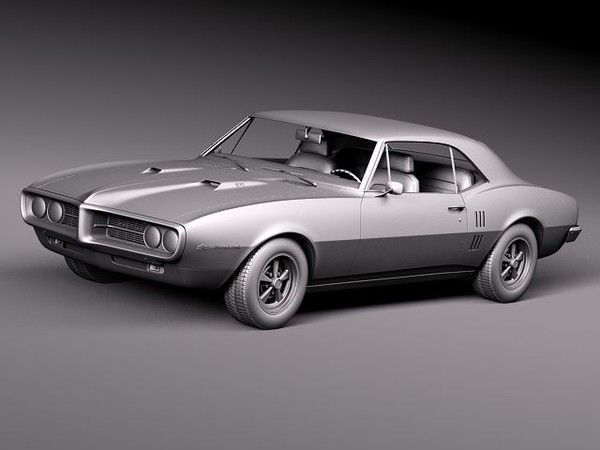


Image courtesy of Hot Rodding



3D Concept Design!


There was a time when General Motors was proud of the Firebird and wanted to see it thrive, rather than letting it die a slow, lingering death. It was such a beauty and so unfortunate it suffered this fate.

Image courtesy of Hot Rodding
Sadly, that time was nearly four decades ago, when the "ponycar" (loosely defined as a front-engine, rear-drive two-plus-two built by an American manufacturer) was considered a hot product.

The introduction of the Ford Mustang in the spring of 1964 had set the automotive world on its ear, and the competitors from General Motors and Chrysler were scurrying to catch up. The Pontiac Firebird was GM's answer to the Mustang and it made an impact indeed!

The Pontiac Firebird, was merely a GM concept car for 14 years that had many renditions. There were even other interesting concept cars John DeLoren suggested to push the Pontiac name to the top of the best sellers list...Yes a two seat hardtop coupe Firebird was planned!
A Brief Segue...
Delorean always had a fascination with Maseratis and two seat sports cars. As general manager, he strongly felt Pontiac should have a two seat sports car in their model line up to further promote Pontiac's performance image and bring in showroom traffic. He developed fiberglass bodied two seat experimental sports cars, named XP-833 Banshee. Two prototypes were built, a two seat hardtop coupe powered by an OHC-6 and a two seat convertible roadster powered by a 326 V8. Unfortunately, the XP-833 was not approved by GM executive management due to the potential of cannibalizing sales of the two seat Chevrolet Corvette. These two prototypes still exist and today are in private collections.
XP-833 Banshee Coupe with OHC-6
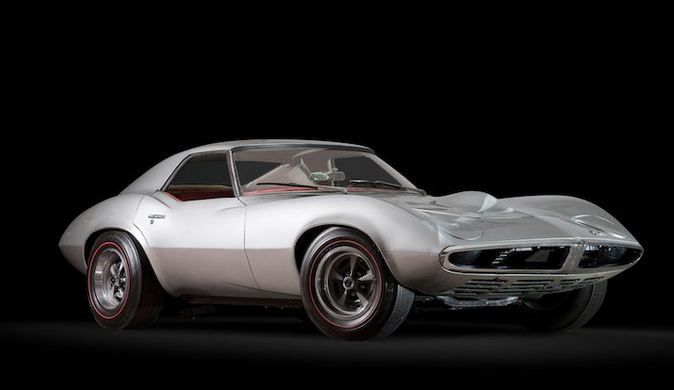
Courtesy of www.pontiacsonline.com/JOHN%20DELOREAN.htm
XP 833 Banshee Convertible with 326 V8

Courtesy of www.pontiacsonline.com/JOHN%20DELOREAN.htm

Courtesy of www.pontiacsonline.com/JOHN%20DELOREAN.htm
XP 833 Banshee Convertible with 326 V8

Courtesy of www.pontiacsonline.com/JOHN%20DELOREAN.htm
During his reign as general manager, he commissioned several two seater sports car concepts. Another was the XP-798 Banshee which was to debut at the New York Auto Show in 1966. However, GM's President Jim Roche ordered the concept car to be removed from public viewing. He said that the Pontiac concept car would take away from GM's safety image.
To appease Delorean's plea for a small sporty car for Pontiac's model lineup, Pontiac did get approval for a sister version of the new Chevrolet Camaro. Thus the Firebird was born for model year 1967.
This Firebird was finally brought to production as GM's answer to combat Ford's Mustang! It didn't quite have the same sales but it quite successful and had a production run from 1967 - 2002.
Below is an advertisement for the new Pontic Firebird.

Below is an artist rendition of the 1967 Pontiac Firebird in all its glory! You got it Pontiac! It deed indeed have it too!
Oh how we miss you...


The 1967 Pontiac Firebird in a stunning blue color with beautiful wheel rims!


But now we need to go back to where the Firebird concept car all began...back to 1953 where it all essential began...when this Firebird was just a dream concept car...
Introduction...
The Pontiac Firebird design, style and shape didn't being like the release we all know in 1967. Simply put, the original concept designs were way out there...
That original Firebird plane logo basically represented what this car could do and that is soar to the sky! Pay close attention to the original ideas and actual Firebird concept cars I'm about to present. These are cool and radical...as well as GM showing off and flexing their design skills!
The General Motors Firebird is a trilogy of three prototype cars designed by Harley Earl, and engineered by General Motors for the 1953, 1956 and 1959 Motorama auto shows. They were very much inspired by innovations in fighter aircraft design at the time. None of the designs were intended for production, but instead were to showcase the extremes in technology and design that General Motors was able to achieve. The cars were recently placed on display at the Henry Ford Museum in Dearborn, Michigan, and still make regular car show appearances.

General Motors had done research on feasibility of gas turbine engines in cars as early as the 1930s. It wasn't until the early 1950s that they began building an actual engine, with Emmett Conklin leading the project. The top speed of all 4 of them are 200 MPH.
Firebird I - 1954
By 1953, the research team had produced the Firebird XP-21,[1] later referred to as the Firebird I, which was essentially a jet airplane on wheels. It was the first gas turbine powered car tested in the United States. The design is entirely impractical, with a bubble topped canopy over a single seat cockpit, a bullet shaped fuselage made entirely of fiberglass, short wings, and a vertical tail fin.[2] It has a 370 hp (280 kW) Whirlfire Turbo Power gas turbine engine, which has two speeds, and expels jet exhaust at some 1,250 °F (677 °C). The entire weight of the car is 2,500 lb (1,134 kg) and had a 100 inch wheelbase.[3]

At first, Conklin was the only person qualified to drive it, and he tested it up to 100 mph (160 km/h), but upon shifting into second gear the tires lost traction under the extreme engine torque and he immediately slowed down for fear of crashing. The car was later test driven at the Indianapolis Speedway by race car driver Mauri Rose. The car was never actually intended to test the power or speed potential of the gas turbine, but merely the practical feasibility of its use. The braking system differs from standard drum systems, in that the drums are on the outside of the wheels to facilitate fast cooling, and the wings actually have aircraft style flaps for slowing from high speed.

A miniature version of the Firebird I crowns the Harley J. Earl Trophy, given to the winner of the Daytona 500.
The idea of the Firebird originated with Harley Earl who also designed its fibreglass, reinforced plastic body. The car's Whirlfire Turbo-Power engine and the chassis were developed under the direction of GM Vice President Charles McCuen, general manager of GM Research Laboratories Division.
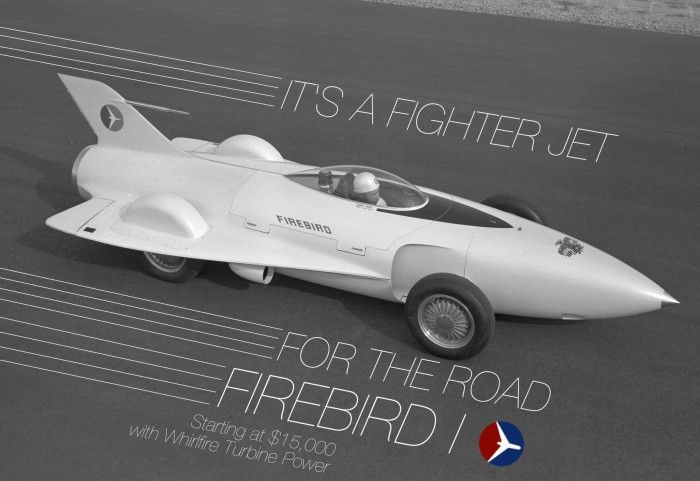
The aircraft motif is evident in the car's "needle" nose, delta wings swept back over the rear of the body, a vertical tail fin and a plastic bubble over the driver's cockpit.

Mechanically, the gas turbine of the Firebird is the reverse of conventional automobiles. In the nose, ahead of the driver is a 35-gallon glass fibre-plastic fuel tank. Behind the driver is an integrated power "package" with an engine consisting of two mechanically independent parts - the gasifier section and the power section.

Firebird II - 1956
The second concept car, the Firebird II in 1956, was a more practical design: a four-seat, family car. It is a low and wide design with two large air intakes at the front, a high bubble canopy top, and a vertical tail fin. Its exterior bodywork was made entirely of titanium(which turned out to be hard to make).[4] The engine output was 200 hp (150 kW), and to solve the exhaust heat problem it was fed through a regenerative system,[4] which allowed the entire engine to operate at nearly 1,000 °F (538 °C) cooler, and also power the accessories.

Kerosene was the most common fuel used.[4] Another innovation on the car was the first use of four wheel disc brakes, with a fully independent suspension, as well as a sophisticated guidance system which was intended to be used with "the highway of the future", where an electrical wire would be embedded into a roadway to send signals that would help guide future cars[5] and avoid accidents.

Specifications
Wheelbase = 120 in (3,048 mm) [6]
Length = 234.7 in (5,961 mm) [6]
Ground clearance = 5.5 in (140 mm)
Firebird III - 1958

The third design, the Firebird III, was built in 1958 and first shown at Motorama in 1959. It is another extravagant concept with titanium skin, and no fewer than seven short wings and tail fins that were tested extensively in a wind tunnel.
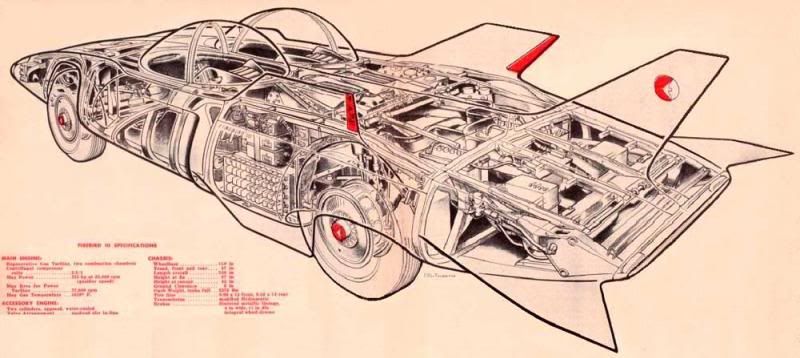
It is a two-seater powered by a 225 hp (168 kW) Whirlfire GT-305 gas turbine engine, and a two cylinder 10 hp (7.5 kW) gasoline engine to run all the accessories. Its exterior design features a double bubble canopy, and more technical advancements to make it more practical, such as cruise control, anti-lock brakes, and air conditioning. It also featured "space-age" innovations, such as special air drag brakes, like those found on aircraft, which emerged from flat panels in the bodywork of the car to slow it from high speeds, an "ultra-sonic" key which signaled the doors to open, and an automated guidance system to avoid accidents and "no hold" steering. The steering was controlled by a joystick positioned between the two seats.[7] This gave the car a more futuristic feel and simulated the experience of flying a plane.

Specifications
Wheelbase = 119 in (3,023 mm) [8]
Length = 248.2 in (6,304 mm)
Height = 44.8 in (1,138 mm) (canopy top)[8]
Ground clearance = 5.3 in (135 mm)
The Firebird III was the first space age inspired car by General Motors. The Firebird III has an aerodynamic fiberglass body and is pearlescent silver-gold in color.
But wait, there's even a 4th Prototype...
Firebird IV (XP-790) - 1964
The Firebird IV debuted at the 1964 New York World's Fair, it was displayed in three variants Firebird IV Runabout and Stiletto.

The Firebird IV, another sleek, turbine-powered car with strong aircraft styling cues.

It was definitely hailed as a prototype and if the Ford Mustang never came along this would have remained as such. For 14 years, the GM designers continued to tweak the prototype type designs. These were show cars and never meant to be actual road worthy automobiles.

The Runabout 3-wheeled concept car by GM is the "Runabout". The vehicle had a front wheel that could turn 180 degrees to allow parking in the tightest of spots and the rear end of the car contained two detachable shopping trolleys with wheels that would fold away when the trolley was parked in the vehicle. The Runabout had space for 2 adults in the front and 3 children in the rear. [9]

Firebird IV-Stiletto - 1964
The GM-X Stiletto was an advanced, high-performance car with styling strongly influenced by aerospace design. It featured aircraft-type steering, a maintenance monitoring system with toggle switch controls, and a three-way speaker system for inside/outside communications.[10] In 1969 the GM-X Stiletto got a nose job, some new paint and was renamed as the Pontiac Cirrus.[11]

These vehicles were first presented at the General Motors Futurama Exhibit in 1964 at the New York World’s Fair.


For those of you model fanatics who want to have models of everything in 2001, you’re in luck… GM got patents on each of these designs, so there are drawings available. Also available is a list of dimensions for the three vehicles, certainly handy for scale modelers.
Firebird IV Patent I

Firebird IV Patent II

Stiletto Patent I

Stiletto Patent II

Roundabout Patent

Specifications

Sources for images and information are courtesy of...
www.autospeed.com/cms/article.html?title=Revisited-The-GM-Concept-Cars&A=110992
en.wikipedia.org/wiki/General_Motors_Firebird
blog.hemmings.com/index.php/tag/firebird-iii/
www.pontiacsonline.com/JOHN%20DELOREAN.htm
www.cartype.com/pages/5778/gm_xp-21_firebird_1__1953
musclecarfilms.com/1969_Firebird_Engineering_Cars_3.html
1967 Pontiac Firebird
A real car with plenty of style, power, and handling!
Pontiac announces not one, two, three or four, but five new magnificent new Firebirds for every kind of driving...

A real car with plenty of style, power, and handling!
Pontiac announces not one, two, three or four, but five new magnificent new Firebirds for every kind of driving...

Finally in 1967 the Pontiac Firebird is given the green light and is ready to launch!


The Pontiac Firebird is an automobile which was built by the Pontiac division of General Motors between 1967 and 2002.
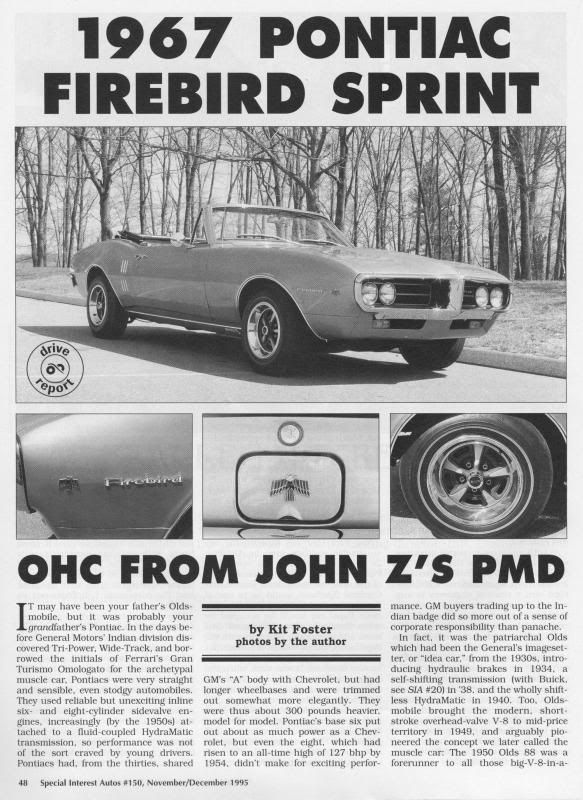

These are some of the ads GM launched for its new Pontiac Firebird! Was this exciting, you betcha!!!






The Firebird was introduced the same year as the automaker's platform-sharing model, the Chevrolet Camaro. This coincided with the release of the 1967 Mercury Cougar, which shared its platform with another pony car, the Ford Mustang.

The vehicles were powered by various four-cylinder, six-cylinder, and V8 engines sourced from several GM divisions. While primarily Pontiac-powered until 1977, Firebirds were built with several different engines from nearly every GM division until 1982 when GM began to discontinue engines it felt were unneeded and either spread successful designs from individual divisions among all divisions or use new engines of corporate architecture.[1]

1968 Pontiac Firebird
The Pontiac Firebird iconic logo!

Oh my, what a beauty!!!
The Pontiac Firebird...

The styling difference from the 1967 to the 1968 model was the addition of Federally mandated side marker lights:


For the front of the car, the turn signals were made larger and extended to wrap around the front edges of the car, and on the rear, the Pontiac (V-shaped) Arrowhead logo was added to each side. The front door vent-windows were replaced with a single pane of glass.
Gotta love the catalog promotional pictures for the Pontiac Firebird. So retro and so cool!

The Custom...the one...the only...Pontiac Firebird!
Looks spectacular in RED!!!

Boy did this car ever look so HOT!
Why did Pontiac modify this classic look so much until it became a shodow of its former self...

Here is another advertisement promoting the new 1968 Pontiac Firebird!

1969 Pontiac Firebird
The Origins Of The 1969 Trans Am Design
Note: Harry Bradley, Hot Wheels first designer, played a major role 1969 Trans Am design!
In the Fall of 1967, designer Gene Winfield and designer/artist Harry Bradley approached Pontiac with a proposal they called the "Firebird Can
Am". Gene Winfield was actually a consultant under contract for the plastic model company AMT, and therefore he had advance notice as to
what the 1969 Firebirds would like long before they were introduced to the public. Since the Pontiac Special Projects Group were still involved in
refining the suspension for the 1968/1969 Firebird, and had gained tremendous experience on the race track racing their SCCA 1968 Firebird, the
Winfield/Bradley drawings were the first designs to seriously be considered by Pontiac as a possible look for their new "ultimate Firebird".

The most obvious part of the Winfield/Bradley design that would eventually end up on the production 1969 Trans Am were the hood scoops, rear
wing, and side air extractors. The Winfield/Bradley rear wing would take on a few different looks, courtesy of the Pontiac Styling Department,
before a full-width floating style was adopted, but the design for the hood scoops and side scoops came through nearly intact. One thing that did
not appeal to Pontiac was the proposed color of the Winfield/Bradley design. In its original art form, this "Firebird Can Am" was a greenish color
with gold accents. A visually striking (and functional) styling cue are the brake cooling scoops mounted in place of the parking lights. The front
grilles on the production 1969 Firebird would have an "egg crate" look, and the Winfield/Bradley design brought that egg crate pattern down into
the parking light openings. As we shall see in the next segment on the first Trans Am prototype, the Pontiac Special Projects Group and the Styling
Department created a prototype that looked very similar to these sketches.
Image and information courtesy of musclecarfilms.com/1969_Firebird_Engineering_Cars_2.html
The 1969 model received a major facelift with a new front end design but unlike its big brother the GTO, it did not have the Endura bumper. The instrument panel and steering wheel were revised. The ignition switch was moved from the dashboard to the steering column with the introduction of GM's new locking ignition switch/steering wheel.

This is a 1969 Pontiac Firebird die-cast replica.

Artists Rendition of the 1969 Pontiac Firebird 400

blag.illicitsnowboarding.com/2013/08/art-inspiration-impressive-array-of.html

blag.illicitsnowboarding.com/2013/08/art-inspiration-impressive-array-of.html
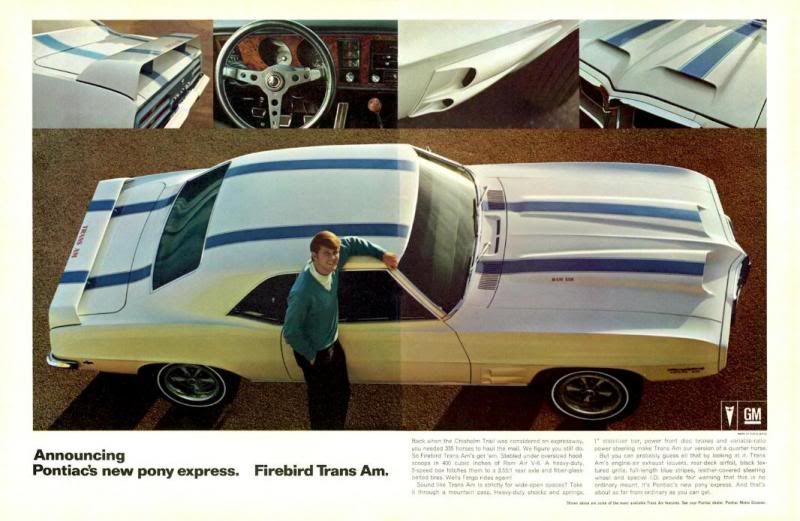
1970 Pontiac Firebird


1971 Pontiac Firebird








1972 Pontiac Firebird
After continued success and steady rise in popularity of Pontiac Firebird from its inception in 1967 General Motors gave serious thought to dropping the firebird altogether in 1972.

Pony car sales had fallen dramatically from their 68 high, the year pony cars captured 11% of the national market. By the end of 1971, that figure had dropped to 3.9%

Flagging sales , the safety controversy, a declining interest in muscle cars, and fast rising insurance rates for the higher-horsepower models all conspired to put an end to all pony cars. Many did drop by the wayside during this general period, and even the down sized Mustang soon became a mere ghost of its former self.

Worse than that, though, the United Auto Workers (UAW) decided to strike GM's Norwood, Ohio, plant in 1972- the only plant then producing Firebirds and Camaros.
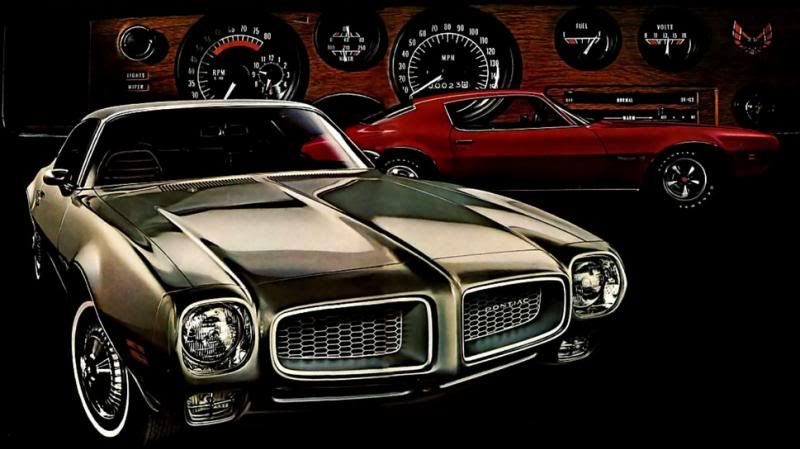
1973 Pontiac Firebird


Here is another advertisement from Pontiac promoting their new style of the Firebird!
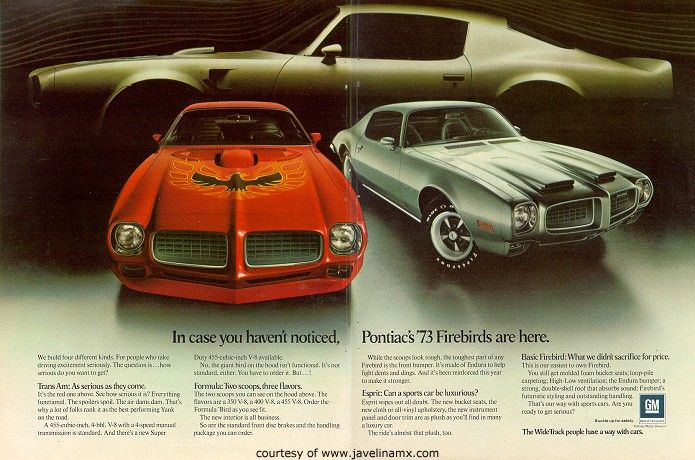
More wallpaper images of the 1973 Pontiac Firebird
1974 Pontiac Firebird
I will eventually list every year the Pontiac Firebird was issued.
I just need some time...

There were several other years that will be featured going forward...
1989 Pontiac Firebird

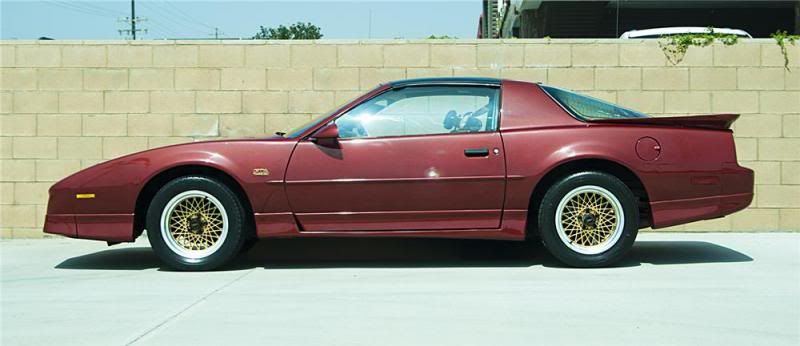
1989 Pontiac Firebird



Other sources...
www.highperformancepontiac.com/features/hppp_0707_pontiac_firebird_designer_bill_porter/viewall.html
Hot Wheels - Custom Firebird!


Harry Bradley, Hot Wheels first designer made the decision to include the Pontiac Firebird in the Hot Wheels line-up of cars! That Pontiac Firebird was hot indeed and fit the description of California Custom styling. Hence the "Custom Firebird" was born! Eventually Hot Wheels released several other Pontiac Firebirds that were released through the years. Quite a few of them. These be listed as time progresses...
Ah yes, this looks amazing in spectraflame red!
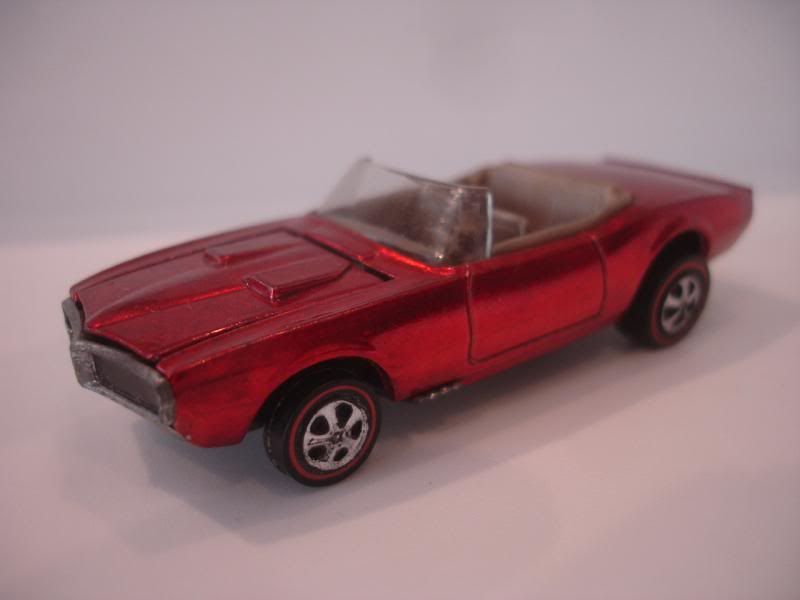
Here is another rendition in....Mattel's candy colored paints which they call Spectraflame and wouldn't you know it, seems like I chose red again! It sure must be a popular color on the Pontiac Firebird! Heck why not the red looks so cool! A two door Firebird Sport Coupe would have been something as well. Too bad the Corvette didn't want to share the limelight.
Today these Spectraflame type of paints are no longer used. There is a new paint process which Mattel classifies as SpectraFrost! So that's it so far for the paint evolution. I'm just curious what Mattel used for the Ultra Hots series in the 80's. Some of those finishes and high gloss paints were similar to the spectraflame paints. Seems nobody even noticed.

The Custom Firebird on an original United Kingdom blistercard! Yes the Rosebud Card!
Hmmm, the North American cars face the opposite way...
Yes you noticed this Custom Firebird is in red again...

The matching Custom Firebird collector button!
Who would have expected this to be in the color..... R E D ...
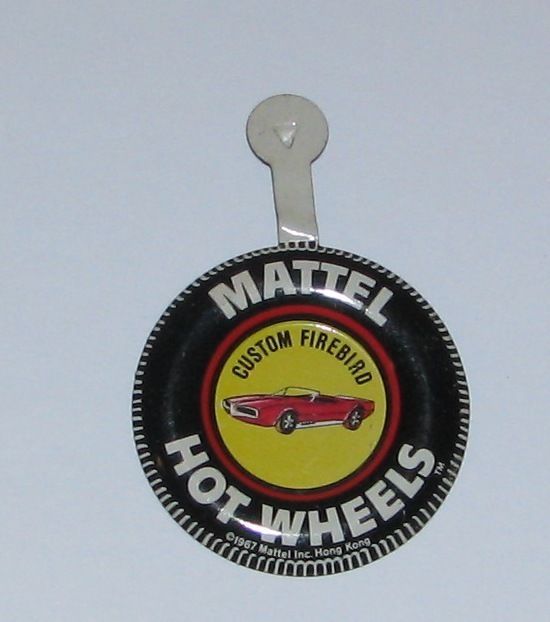
Here is another version of the Custom Firebird with real rider red striped wheels. This looks stunning!
Finally a color change!

This one is a beauty!!!

Hot Wheels - Spoilers - Light My Firebird
This Custom Firebird was so popular that it was added to the Hot Wheels Spoilers line when that was released in 1970.
It was given a cool name too by the Mattel namesmith. Light My Firebird!!! Perhaps this name was influenced after the Doors hit song "Light My Fire"!
Green looks cool!

For the 30th Anniversary Mattel decided to do a special tribute to the Spoilers series and released this 4-car set which included "Light My Firebird".
Looks green to me...the overblown engines you see in the set were never used again. Call them one offs or prototypes! Collectors just didn't take kindly to these.

Image courtesy of Robinator
Mattel retooled the overblown exaggerated engines and brought back the original Spoiler engines. A big thank you from all us collectors.

Here is an image of the Light My Firebird released in the wild!
This is from the Hot Wheels Redline Club...

Image courtesy of Robinator
Hot Wheels Redline Club Release 2007

Recent Hot Wheels Regular Line Release


Hot Wheels Trans Am...

Further Hot Wheels releases...


2010


2013 Cool Classics

Matchbox Release

Tomica's Pontiac Firebird die-cast model

More detail will follow...
Like this...if you like Firebirds...visit this link below:
www.firebirdtoys.com/
The Phoenix Rises...
Is this a symbol of the Phoenix or the Pontiac Firebird?
Will the Phoenix Firebird ever rise from the ashes without the name Pontiac associated with it?

Apparently the Phoenix Firebird has risen from the ashes as told in Greek Mythology. Pontiac brand is also resurrected along with the Phoenix Firebird.
2010 Firebird...

2011 and continues to be produced...






Firebird 2012


Firebird 2014

Source
www.amcarguide.com/concept/2011-pontiac-firebird-trans-am-concept/









